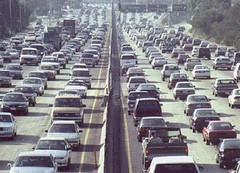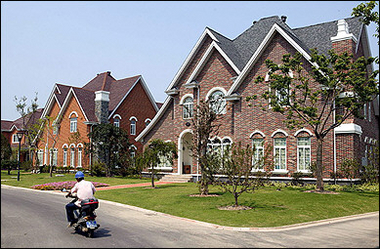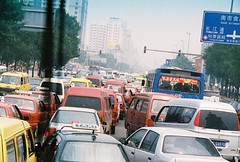Asking the wrong questions about energy security
 From Transit Villages.
From Transit Villages.Froma Harrop, a columnist for the Providence Journal, writes "Don't blame the Chinese for this nation's oil woes," about the need to reduce U.S. oil consumption and the proposals of the Set America Free coalition, which focuses on the link between energy consumption and national security. From the article:
Not all problems facing America are caused by oil — only about 96 percent of them. National security, the economy, the environment and even the weather are tied to our reliance on oil. So when the leadership in Washington fails to take serious action on cutting oil use, it fails big-time. Everyone seems to get this but the Bush administration...
In any case, there are plenty of customers to buy oil from the scary Iranians. The way to defang their leaders is to send oil prices collapsing. In theory, the United States has the brains and resources to do that.
To this end, a group of defense experts, evangelicals, environmentalists, neo-cons and liberals has formed the aptly named Set America Free Coalition to push for oil conservation and develop alternative energy sources. That sounds like just about everyone in America — except, unfortunately, the politicians running the show in Washington.
The problem with the Coalition is that their Blueprint for Energy Security says nothing about transit and alternatives to automobile-centricity. America consumes gobs of oil, which probably does cause 96% or so of our nation's problems.
But the question that isn't being asked is why does the U.S. consume so much oil? It is to fuel sprawl and its automobility.
Single use, low density developments are connected in large part by personally-owned automobiles. The Set America Free agenda seems to look at technology as a solution to oil security issues, without questioning how this oil is used.
As Jane Jacobs says (I think in The Nature of Economies) in reference to traffic congestion (paraphrased), "You're asking the wrong question. It's not why aren't there enough roads, but why are there so many cars?"
Why is the United States using so much oil?
It's not just about overuse, such as with hulking SUVs and Hummers, it's really a much more fundamental question, about compact development vs. sprawl.
And this is an important question because gasoline is an incredibly "efficient" energy source for automobiles, compared to alternatives. Even with great technology advances, how likely is it that enough alternative energy sources can be created that can power "a car for every garage" (and street and structure parking spot, and back lots, and alley spaces...).
See for example, the article Green Manhattan, originally from the New Yorker, for an alternative perspective about housing and living choices and the efficient use of energy.
Because the world-view of the Set America Coalition is so circumscribed, as a link, it doesn't meet my standards for quality and recommendation, so I won't be adding this organization to the list of Environment & Energy links in the right sidebar.
 I disagree with the headline of this graphic. Suburbanites might not be "villains," but the development type they embrace causes "96% of our nation's problems," and as Ms. Harrop says, funds both sides of the "War on Terrorism."
I disagree with the headline of this graphic. Suburbanites might not be "villains," but the development type they embrace causes "96% of our nation's problems," and as Ms. Harrop says, funds both sides of the "War on Terrorism."Note that the suburban average of BTUs consumed for transportation is 400% greater than the urban average.
Why is the United States using so much oil?
And if you want to get really scared, why is China trying so desperately to adopt U.S. style development practices?
 A view of Thames Town outside Shanghai. Chinese professionals have flocked to purchase some of the 800 units in the one square kilometre urbanisation that is half near completion and will eventually house some 8,000 well-to-do residents. Villas retail for a minimum of nearly $500,000. (AFP)
A view of Thames Town outside Shanghai. Chinese professionals have flocked to purchase some of the 800 units in the one square kilometre urbanisation that is half near completion and will eventually house some 8,000 well-to-do residents. Villas retail for a minimum of nearly $500,000. (AFP) China and automobility.
China and automobility.Index Keywords: sprawl; car-culture; energy



0 Comments:
Post a Comment
<< Home